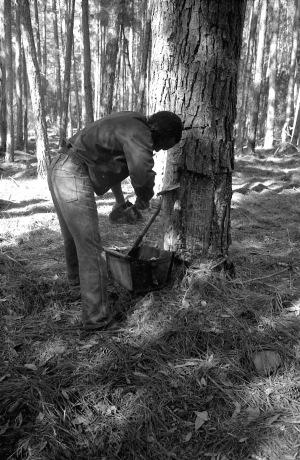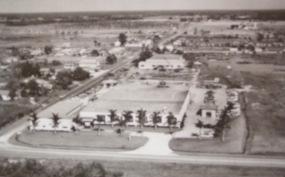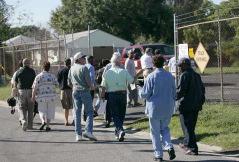Inc




Tallevast, Florida, is a predominantly Black, unincorporated community between Manatee and Sarasota Counties. If anyone outside of the area knows of the town of fewer than eighty homes spread across two square miles, it is likely because, about twenty years ago, its groundwater was discovered to have been poisoned by the manufacture of weapons-grade beryllium during the Cold War
The plot will sound familiar.Apolluting industry, privately owned but authorized by the state, is placed near Black homes, fouls the natural resources, and causes irreversible harm to the community’s health. Environmental racism is global, but it is particularly common to Black communities in the U.S. South, where state authorities tend to allow more latitude to industrial polluters. Consider Warren County, North Carolina, where a dump for the neurotoxin PCB was sited adjacent to the homes of poor Blacks. Or Louisiana’s “Cancer Alley,” where petrochemical production has devastated dozens of Black communities along the banks of the Mississippi. Such occurrences extend the timeframe of plantation-like mechanisms of control and dispossession. Of course, it’s not only in the South. Change a couple key details and you have Flint, Michigan, or Secunda, SouthAfrica.
Environmental racism is global, but it is particularly common to Black communities in the U.S. South, where state authorities tend to allow more latitude to industrial polluters.

This essay is featured in Boston Review’s new book, Climate Action.
February 3, 2021
First, segregation blocked this Florida community from equal education and other public goods. Then the military–industrial complex sickened residents and destroyed their property
In 1996 the defunct LoralAmerican Beryllium Company (ABC) was purchased by Lockheed Martin, the world’s largest defense contractor and the top employer of Florida’s industrial workforce.The acquisition extended Lockheed’s already notable presence in Florida, which has been continuous since 1956 when, as Martin Marietta, it established a missile plant in Orlando. Once it procured ABC, Lockheed worked with Florida governmental agencies to hide ABC’s sins from Tallevast residents. The collusion is documented in over 1,800 documents held in Florida’s public environmental records database. By combing through these records—which include memos, interoffice emails, meeting minutes, and environmental assessments—we have been able to reconstruct the story of how, between 2000 and 2004, corporate and state actors knowingly withheld information from Tallevast residents about the contamination in their community.



Across the street is the Sarasota Bradenton InternationalAirport (SRQ), which increasingly welcomes sports stars traveling to IMGAcademy, recent host of the WNBA’s COVID bubble. On the other side of SRQ lie the Ringling Museum ofArt and New College of Florida, the state’s prestigious liberal arts institution. At Tallevast’s boundaries are an office park for the pretzel maker Snyder’s of Hanover and Suncoast Golf Center, a three par golf course, where on any given day elderly white men practice their midrange strokes.
Tallevast possessed a vitality of southern Blackness before Sarasota’s postindustrial commercial sprawl began squeezing the life from it. On Fridays and Saturdays, the smell of barbequed meat from grills on front lawns wafted through the air and the energy of youth reverberated in the streets—competitive pickup basketball games on outdoor courts, motorized bikes roaring on pavement.And on Sundays, Baptist, Methodist, and Holiness churches gathered to worship and remember how far they had come.After praise services, at least in earlier generations, residents would reconvene for picnics on the turquoise waters of Sarasota Bay, just over a mile away
spoke of Tallevast’s golden days at a January 2019 community meeting. Then ninetythree, making her the oldest living member of the community, she was part of the third generation of Tallevast residents, a grandchild of one of the founding families who had migrated to the small town when it was a labor camp for the Tallevast family’s turpentine business. Educated in Manatee County schools, Heathington then earned a degree in nursing from FloridaAgricultural and Mechanical University (FAMU) before entering the United States Air Force. After being stationed all over the world, she returned to Tallevast in the 1970s with her husband, Clifford, to raise their three children, so that the community could help instill in them the values it had given her. “It was a place you could raise your children without too much worry,” she would often tell young people during community meetings, “because you knew there was always someone watching them. . . . Most of the people . . . all worked hard to keep their children in school and send them off to college for a better life.”

In the early days, residents of Tallevast were subject both to Jim Crow racism and geographic discrimination. Heathington told of how Manatee County would not even provide Tallevast’s students with transportation to the county’s one segregated Black high school. Instead, Mr. Ulysses “Rip” Ward, who operated a group of day laborers, would drive the students to school in Palmetto, thirty minutes away The vehicle, an “old bread truck” with benches nailed in the back, would break down periodically and make the students late for school. If the students arrived late for morning assembly, the principal would stop mid-sentence and say, “And here comes Tallevast!” Tallevast children were not only humiliated by their inferior mode of school transportation, but also by how their principal repeatedly brought attention to it in a way that reinforced beliefs about the rural community’s lack of decorum and intelligence.
Despite general neglect—Tallevast was one of the last towns in Manatee County to receive street lights, paved roads, telephone lines, and sidewalks—for at least two generations the community’s young people went to college at a higher rate than students in other Manatee County districts. Heathington and her sister Mrs. Lillian Granderson were among Tallevast’s first residents to finish a four-year degree.After them, Tallevast would send four or five young people to college each year As in many Black communities, education was seen as a salvation, a catalyst for the community’s growth. Elders hoped their children would acquire knowledge and bring it back to Tallevast for its continued evolution.
“When a small industrial plant for engineering metals was built in the center of Tallevast in 1957, residents hoped it would bring jobs and development. Four years later, it became focused on beryllium.”

When Visioneering, a small industrial plant for engineering metals, was built in the center of Tallevast in 1957, residents hoped it would bring jobs and development. Four years later, Visioneering’s machining became focused on beryllium, and the company changed its name toAmerican Beryllium Company (ABC). Beryllium is a metal used for missiles, rockets, and nuclear reactors because of its lightness, strength, and capacities to conduct electricity at high temperatures. Because the machining of beryllium generates toxic dust and requires organic solvents for cleaning, a system was installed to mitigate the dangers, including subsurface sumps to collect wastewater and a 9,000-square-foot artificial evaporation pond to hold effluent.
While allABC workers were likely exposed to beryllium levels that exceeded legal limits, its custodial workers, some of whom were Tallevast residents, were more likely than others to contract berylliosis (chronic pulmonary granulomatosis), a chronic and incurable disease that scars lung tissue, shortening the breath and stressing the heart. One resident, Mr. Charles Ziegler, contracted berylliosis from working as a janitor at ABC for over twenty years. BeforeABC, he was an independent roofer, but switched to ABC because it paid much better, providing him a wage of between $15 and $17 an hour.As anABC custodian, Ziegler vacuumed beryllium dust from the tables holding machining equipment, filtered the dust into bags, and transported the bags to bathhouses where he dumped the dust into a drum. After capping the drums, he washed the bags and then shipped them off site for recycling or further disposal. “I liked the work atAmerican Beryllium,” he told a focus group of formerABC employees in 2012. “The work wasn’t hard, not hard at all. They didn’t push you too hard. . . . [But I] didn’t know anything about beryllium—[it was] no different [to me] than a grain of sand.”



Ziegler had little control over the “charcoal-like” beryllium dust. It would seep out from the bags and spill from capped drums. “It didn’t make any difference how you did it,” he explained to his colleagues during the 2012 focus group, “the dust would escape because it was so light.” Other employees would wash the bathhouses that contained the drums of beryllium, which would then disperse the dust into the community. Ziegler held a clear memory of this: “Do you know where all that stuff went to? On the road, see? . . . They’ll never get rid of all of it. And I guarantee . . . if you would . . . tear it down, you could go over there, and I bet you’ll find some beryllium.” Ziegler lived across the street from the facility and would bring the dust home with him: “Yeah, you take it home. Take it home in my clothes.”
Ziegler’s wife, Beatrice, and her brother, Leroy Mazon, who lived with them, also developed berylliosis.

“Beryllium dust would seep out from the bags and spill from capped drums. All ABC workers were likely exposed to beryllium levels that exceeded legal limits.”

Manatee County officials reported in 1992 that ABC was not considered an “environmentally regulated site.” But the Florida Department of Environmental Protection (FDEP) consistently monitored ABC, conducting at least seven inspections between 1982 and 1995. And even with knowledge of the dangers of beryllium dust, FDEP did not monitor its aerial dispersal as strongly becauseABC drummed and shipped it for recycling to Brush-Wellman, Inc., the country’s largest beryllium supplier in Ohio.
Nonetheless, the dangers of beryllium dust had been documented since at least the 1940s, and even more specifically at theABC facility in the mid-1980s by Dr. Lee Newman, then head of the Division of Environmental and Occupational Health Services at National Jewish Medical and Research Center

Newman found that there were no barriers between the machinery and the front office atABC, and its lathes and grinding machines were not confined to individual rooms as at other plants, increasing laborers’ risk of exposure to beryllium dust.


Of greater concern to FDEP in its multiple inspections was the forty types of organic solvents used to degrease products and mill instruments during the daily operations. This liquidwastewasfunneledthroughfloordrains and into sumps, each up to 105 cubic feet in size, about the size of a compact car. For years, FDEP inspections vouched that solvent waste was being drummed and shipped to off-site chemical waste facilities. But in fact, much of the waste was simply remaining in on-site storage tanks.
acquired ABC when it purchased the Loral Corporation. The following year, Lockheed hiredTetraTech, an environmental consulting firm, to conduct environmental and facility assessments to prepare the property for sale. Tetra Tech initially found that the site was in compliance with all state environmental regulations.After cleanup target levels for soil and groundwater contamination changed in 1999, however, Tetra Tech was forced to revise its reporting. On January 20, 2000, Tetra Tech and Lockheed disclosed to the Manatee County Environmental Action Commission that petroleum levels in soil exceeded the new standards. In a separate letter sent to the same agency eight days later, they then disclosed that groundwater had been contaminated with organic solvents and metals from “an unidentified source.”
The facility assessment report thatTetraTech had conducted in 1997, which initially held ABC in compliance with target levels, actually revealed that sumps contained solvents and that on-site storage containers were full of solvent waste. Lockheed Martin reported the contamination in 2000, but it is unclear when the company first realized that waste storage containers were leaking solvent- and metal-tarnished wastewater into the soil and groundwater. During these interagency exchanges about the deadly toxins flowing beneath Tallevast, no one in the community was notified.
The facility assessment report thatTetraTech had conducted in 1997, which initially held ABC in compliance with target levels, actually revealed that sumps contained solvents and that on-site storage containers were full of solvent waste. Lockheed Martin reported the contamination in 2000, but it is unclear when the company first realized that waste storage containers were leaking solvent- and metal-tarnished wastewater into the soil and groundwater. During these interagency exchanges about the deadly toxins flowing beneath Tallevast, no one in the community was notified.
Of all the solvents that ended up poisoning the groundwater,
the one that caused the most concern was trichloroethylene (TCE). For much of the twentieth century, TCE was common in dry cleaning, as an anesthetic, and as an industrial cleaner The pervasiveness of TCE meant that exposure to the chemical was widespread. The health impacts of TCE exposure have been known since at least 1915, but epidemiological studies conducted in the 1950s revealed that sustained exposure to TCE is linked to a variety of psychological disorders and significantly higher risks of kidney cancer, liver cancer, Hodgkin’s and non-Hodgkin’s lymphoma, cervical cancer, and prostate cancer. In 1977 the federal government listed TCE as a priority pollutant in the Clean Water Act; in 1982, the Environmental Protection Agency (EPA) identified TCE as a serious threat to drinking water, establishing a maximum allowable concentration of 5 micrograms per liter (ug/L) of drinking water.
“During interagency exchanges about the deadly toxins flowing beneath Tallevast, no one in the community was notified.
No one told residents that the water beneath them had been poisoned.”
To protect the neighborhood from
Tallevast is designated in “The Manatee Plan”, the County’s Comprehensive Plan as a commnunity development improvement neighborhood. ... The designation enables the County to target limited resources on the area. The strategy for revitalization of Tallevast includes major public facilities improvements, housing improvements, and landuse regulations which protects the neighborhood from industrial encroachment.
Manatee County has already taken steps to ensure appropriate lansuse regulations. Although surrounded by industrial development, industrial rezone and development requests in Tallevast are not consistant with “The Manatee Plan” and cannot be approved by the board of County ommissioners.
Discussion was held regarding the controversy on the airport relocating or realigning its runway in a manner that would have a negative effect on the community of Tallevast and the fact that one branch of government of Housing and UrbanDevelopment(HUD),wouldbeproviding funds for community development in that area while another, the Federal Aviation Authority (FAA), might invalidate those improvements.
County staff reported she had inquired of the intergovernmental relations section of HUD in Washington, D.C., if a similar situation had occured elsewhere whereby another governmental agency through funding jeopardized the investment HUD had made in a neighborhood. HUD there is no precedence or intervention (by HUD) anywhere else in the country and expressed the desire not to become involved should the airport decide to relocate.
Tetra Tech published a Contamination Assessment Report for ABC in April 2001. Organic solvents were found in thirteen monitoring wells on the ABC site. The highest reported level of TCE was 1,500 ug/L—300 times the EPA’s maximum contaminant level. Tetra Tech concluded that organic solvents “may be migrating off-site” and created an illustration that displayed the known extent of organic solvents exceeding groundwater cleanup criteria. Question marks traced the northern and eastern borders of the property, each one signifying that contaminants may have dispersed into the community


Nearly a year later, on March 5, 2002, Lockheed Martin and Tetra Tech informed the FDEP of what had been discovered the previous year. Organic solvents “are migrating offsite,” the report states, and further investigation would be needed to determine the extent of contamination. In its “Interim Data Report and Contamination Assessment Plan Addendum #2,” published on September 13, 2002, Tetra Tech provided analytical results from the sampling of twenty-three on- and off-site wells. TCE was detected at concentrations above the EPA’s maximum contaminant level in fifteen of them. The highest reported level of TCE was 4,300 ug/L—860 times the federal standard.
In Tetra Tech’s “Final Contamination Assessment Report” released in May 2003, a figure illustrates a menacing plume of TCE beneath fourteen homes in Tallevast. But no one told residents that the water beneath them had been poisoned. Conservative estimates of hydraulic conductivity, or the speed that groundwater can be transmitted through soil, indicate that it would have taken four decades for the plume to achieve its size on the 2003 map. It appears that ABC was actively contaminating the groundwater from the start of its operations in 1962.
Just as systemic racism delayed the arrival of basic amenities to Tallevast, residents were brought to municipal water unevenly. Shortly afterABC installed one of its first on-site monitoring wells in 1985 to detect potential contamination on its own premises, Manatee County received a Housing and Urban Development Community Block Development Grant of $1 million to install water and sewer lines in Tallevast. When the funds were exhausted, many community members still had no municipal water, which put them in direct contact with toxins leaking from ABC. The prevalence of wells was common knowledge in the community, but it took state and local agencies two years after Lockheed first divulged the contamination to FDEP to even consider identifying them.
At a March 5, 2002, meeting of representatives from FDEP, Lockheed Martin, and Tetra Tech, the assembled determined: “A private well search needs to be conducted. . . . [P]roperty owners and tenants may also need to be contacted via phone or letter. FDEP will contact the Department of Health regarding permitted wells in the surrounding area.” But instead of contacting the Manatee County Department of Health, FDEP waste cleanup supervisor Michael Gonsalves sent FDEP environmental specialist Kimberly Brooks to Tallevast to look for wells on March 26, 2002. The following day, she emailed Gonsalves to report that she had been to Tallevast and spotted a number of wells, but that her search had been limited because she had at no point exited her car. She wrote that she found Tallevast “very unkempt (to put it mildly).” Brooks then sent a number of emails to Andy Reich, environmental manager of the Florida Department of Health’s Drinking Water Toxics Program, to ask for assistance. Reich in turn dispatched Tom Larkin of the Manatee County Department of Health to search for wells. In an email dated August 7, 2002, Reich shared an image of the area of suspected wells, offered his contacts to support the search, and expressed gratitude to Larkin for his assistance. It remains unknown what Larkin found.

“Tallevast’s Black residents, and the homes in which they lived, were not deemed worth the effort to fulfill the agency’s mission to protect the public.
Tetra Tech writes that “no private wells are being used . . . in the vicinity of the site.” The FDEP did not dispute this assertion, despite knowing that Brooks’s survey, cursory as it may have been, had identified multiple wells. Yet Tetra Tech’s insistence that there were no private wells in Tallevast enabled them to claim, with the FDEP’s endorsement, that residents were not exposed to contaminated groundwater, and so they did not need to be informed about the toxic plume beneath their homes.
The March 5, 2002, meeting also occasioned a debate about where to install monitoring wells for delineating the extent of the contamination. Tetra Tech indicated that these wells would “be completed within the public right-of-way or on private residences,” but Gonsalves advised that it would be more efficient to install wells on public property While the decision on where to place monitoring wells was internally framed as a “private” versus “public” matter, the conversation, much like Brooks’s disparaging description of Tallevast, was racially coded. Tallevast’s Black residents, and the homes in which they lived, were not deemed worth the effort to fulfill the agency’s mission to protect the public.
It was not until September 2003 over three years after Lockheed Martin informed county and state officials of the contamination—that community members became even loosely aware of what was transpiring in Tallevast. An oft-told story is that resident Mrs. Laura Ward, encountering a crew of men operating a drilling rig in her yard one afternoon, asked them what they were doing, to which they responded, “You don’t know, but the water is contaminated here.”
Mrs. Wanda Washington, is said to have learned of the contamination from a repairman who was denied a permit to work on a trailer behind one of the community’s churches, Bryant Chapel, because of the trailer’s suspected contamination. When Ward and Washington together approached local and regional agencies to ask what was going on, they got the runaround: a Manatee County Health Department official sent them to the FDEP Southwest District Office in Tampa; FDEP encouraged them to talk to Lockheed.



had been making enquiries about residential wells,Ward was immediately able to supply a list of twenty-five residences that utilized well water After facing pressure from the community and local media, the FDEP agreed to test them to determine if they had been contaminated by solvents.
On May 20, 2004, the agencies sampled seventeen wells, but with media pressure mounting, Deborah Getzoff, director of the FDEP Southwest District Office, assured the public that “private drinking-water wells in Tallevast are not threatened by pollutants from the formerAmerican Beryllium site.” She could not have been more wrong. TCE concentrations were above drinking water standards in five of the wells sampled that day, ranging from 7.4 ug/Lto 220 ug/L—44 times the EPA’s maximum contaminant level.
When they finally learned in early 2004 that the FDEP

to accept the things
When things go wrong as they sometimes will, When the road you’re trudging seems all up hill, When the funds are low and the debts are high
When things go wrong as they sometimes will, When the road you’re trudging seems all up hill, When the funds are low and the debts are high
And you want to smile, but you have to sigh,
And you want to smile, but you have to sigh,
When care is pressing you down a bit, Rest if you must, but don’t you quit.
When care is pressing you down a bit, Rest if you must, but don’t you quit.
Life is strange with its twists and turns
As every one of us sometimes learns
Life is strange with its twists and turns As every one of us sometimes learns
And many a failure comes about
And many a failure comes about
When he might have won had he stuck it out;
When he might have won had he stuck it out;
Don’t give up though the pace seems slowYou may succeed with another blow.
Success is failure turned inside outThe silver tint of the clouds of doubt, And you never can tell just how close you are, It may be near when it seems so far;
So stick to the fight when you’re hardest hitIt’s when things seem worst that you must not quit.
Don’t give up though the pace seems slowYou may succeed with another blow. Success is failure turned inside outThe silver tint of the clouds of doubt, And you never can tell just how close you are, It may be near when it seems so far; So stick to the fight when you’re hardest hitIt’s when things seem worst that you must not quit.
to accept the things
cannot chang
go or stay?
Living in a state of Mourning and Grief “ I really don’t want to go but I know I can’t stay ” Living in a state of mourning and grief. Constantly looping through the phases of death and uncertainty in regards to your, your family’s future. Being snatched and forced out, away from your comfort zone; the place you call home. The decision to leave was not my own, it was the doings of government. The control over my life seems to been in the hands of someone else. After being pushed and forced out, they are directing me in the way that they wish I can go. My mind takes me to a place of being shackled and chained to a grandios master. Stripped of your freedom: take what I offer or lose it all by force or takings. no wonder I can’t sleep at night!
“ I really don’t want to go but I know I can’t stay ” No wonder I can’t sleep at night.
My ties to this land happened long before my birth. Slaves escaping to freedom vowing to have something for theiroffsprings. I too had that dream in mind. Now I feel I must say goodbye. Leaving behind my legacy, my ancesters legacy, sence of belonging to something/ somewhere and neighbores. At times
I find myself taking on the appearence behaviors of mourning and grief: shocked and disbeliefe, fear, sad, anger and sometimes guilt. I find myself bargaining with myself; stay or go. No peace of mind. Fear of the possibilities of all the unknowns related to the contamination. Lack of trust in those who knew but wouldn’t tell. The same agencies then are watching over us now; no change in behaviors I’ve seen. Because of the color of my skin and/ or the perception of my economic status; protecting me and my family from potential harm was not fit for consideration or valued high enough to tell.
“ I really don’t want to go but I know I can’t stay ”
No wonder I can’t sleep at night.
Just when I think I’ve settled on acceptance dark clouds appear and I sink into a dark place and began to loop through the process again; do I go or do I stay?

“No” I don’t want to go
I can still access the disparate feelings of gratitude, sympathy, and regret his words left with me. My grandfather, Arthur Bryant, Sr., was subtly telling me that he did not have much more time to finish what he had wanted to build for us, his family. He was confiding in me that he did the best he could do to make our lives easier than his had been.
Now, when I think about my grandfather’s desire to bequeath a material legacy to his family, I know that he wanted to provide us with a freedom he believed was endowed by the land he and my grandmother, Ruth, had inherited, acquired, and stewarded in their home community ofTallevast, Florida. He had fought for his freedom by defending his country during the Second World War and by purposefully contesting the special brand of dixie apartheid that separated Tallevast from the rest of Manatee County. But neither my grandfather nor my grandmother envisioned the expanse of the quiet war that had been waged against Tallevast before they were born.
Tallevast, the community in which my grandparents lived and died, surrounds Tallevast Road between “old” Florida Highway 301 (now Fifteenth Street East) and the “new” Florida Highway 301. With about 80 homes spread over an area of roughly five miles wide and ten miles long, the Black community stretches across seven streets, each about three-quartersofamilelong.Ranch-stylehomes with screened-in porches line each quadrant of Tallevast and are separated by thick oak trees and manicured lawns of St. Augustine grass. The Seminole Gulf Railway that runs through Tallevast evenly divides its homes on either side of the tracks, not only physically but also economically—in the distribution of public amenities that tie the community to the enduring legacy of its unincorporated status. Homes on the west side of the railway flush waste via county sewer lines, while those on the east side rely on backyard septic tanks.
a gathering together MAKING TALLEVAST by JAMES MANIGAULT-BRYANTThe risk assessment showed risks from inhalation of TCE to consumers and workers, including bystanders from use as an aerosol degreaser and as a spot cleaner. It also showed risks to workers and bystanders from use as a vapor degreaser. Short-term and long-term exposures can potentially affect the developing fetus. High acute concentrations of TCE vapors can irritate the respiratory system and skin and induce central nervous system effects such as light-headedness, drowsiness, and headaches. Repeated (chronic) or prolonged exposure to TCE has been associated with effects in the liver, kidneys, immune system, central nervous system. EPA has concerns for effects in the developing fetus from both acute and chronic exposure. TCE is carcinogenic to people through all routes of exposure, which include inhalation, dermal (skin), and ingestion.
Bill to stamp out one of the most prevalent groundwater-based cancer-causing chemicals heads to Gov’s desk (Albany, New York) — Today Senator Todd Kaminsky andAssemblyman Steve Englebright announced that legislation they introduced (S.6829/ A.8829) to ban the most harmful uses of trichloroethylene (“TCE”), a known carcinogen and cause of fetal heart defects, passed both the Assembly and Senate. The cancer-causing chemical is still in groundwater, and has been the cause of many high-profile environmental disasters...
“This legislation to ban this dangerous chemical is necessary as a result of federal inaction. The U.S. Department of Human Health Services classifies TCE as known to be a human carcinogen. Banning this chemical is essential to protect human health and the environment,” saidAssemblyman Steve Englebright, Chair of the Assembly Environmental Conservation Committee.
The environmental and human health harms associated with TCE are severe and well-documented. TCE enters the body through air, water, food, and soil — through ingestion, inhalation, or even skin contact. Long-term exposure is strongly linked to various types of cancer, including lymphoma and leukemia as well as fetal heart defects. The U.S. Department of Health and Human Services classifies TCE as “known to be a human carcinogen” and the EPA characterizes it as “carcinogenic in humans by all routes of exposure.” A 2003 study published in the Environmental Health Perspectives, indicated that TCE also caused fetal heart defects. Furthermore, short-term exposure can cause harmful effects on the nervous system, liver, respiratory system, kidneys, blood, immune system and heart.

https://www.nysenate.gov/newsroom/pressreleases/todd-kaminsky/legislature-passes-billkaminsky-englebright-ban-harmful-uses
Officials from state and county agencies attributed their failure to mitigate contaminant exposure to a disintegration of interagency communication. Charles Henry, environmental health director of the Manatee County Health Department, wrote on May 15, 2004, that his department “first became aware of the health concerns of residents and the potential for offsite groundwater contamination near the former American Beryllium plant
when the local media printed the first story on May 1, 2004”—four years after Lockheed Martin had notified the FDEP.

The Manatee County Environmental Protection Department also claimed not to have discovered the contamination until 2004. SarasotaHerald-Tribune reporter Scott Carroll published an article on May 15, 2004, in which he interviewed Karen Collins-Fleming, director of the Manatee County Environmental Protection Department. “Collins-Fleming said she never saw a letter Lockheed Martin sent the county in 2000 notifying it of the pollution and can’t find it anywhere in the county’s file,” Carroll wrote. “The DEP only sent the county a couple of reports on the testing and cleanup efforts out of the dozen or so submitted.” Collins-Fleming adamantly claimed that “this basically has been an issue between DEP and the owner. Since they don’t have any requirement to pull us into the loop, we were unaware.”
The professed collapse in interagency communication extended to the farcical searches for wells. When Paul Panik of the Manatee County Environmental Protection Department inspected the county utility billing records on May 10, 2004, he realized that at least thirteen residences were not paying to be connected to the public water supply With just this cursory search, Panik had already identified four of the five residences whose wells were known to have concentrations of TCE above drinking water standards. If the FDEP had asked the county to examine its financial records earlier, it would have recognized that a number of other Tallevast residents were not connected to the public water supply “ TCE concentrations were above drinking water standards in many of the wells sampled in the community, ranging from 7.4 ug/L to 220 ug/L—44 times the EPA’s maximum contaminant level.”
In fact, the FDEP had to look no further than its own office for information about residential wells in Tallevast: it already held three reports from other projects that identified private wells in the community. But even if officials were unaware of the three reports of wells, or doubted the results of Kimberly Brooks’s search, Lockheed Martin informed Gonsalves that it “had identified what they believed were potable wells near the [former American Beryllium] site to the east (1-2 blocks) of the railroad tracks” during the March 5, 2002, meeting. FDEP held in its own building information it spent months halfheartedly trying to track down outside of it. Meanwhile residents continued to drink water that contained trichloroethylene.
As the realities of the contamination became clearer to the community, Heathington, drawing on her experience as a registered nurse, conducted a health survey of Tallevast residents in 2005. Visiting with every family in Tallevast, she found fifteen cases of cancer spread across the community’s eighty-seven homes, as well as high rates of miscarriage, sterility, and neurological disorders. Heathington’s discoveries convinced her of the need for a systematic study by state officials.
Three years later, the Agency for Toxic Substances and Disease Registry (ATSDR) and the Florida Department of Health’s (FDOH) Division of Environmental Health ran statistical studies assessing the risk of residents getting ill from their exposure to the contaminants measured by the FDEP. Using data from two databases, the Florida Cancer Data System and the Florida Bureau of Vital Statistics, FDOH concluded that while there was a slightly higher number of expected cancers, “causality cannot be assessed” because of the small sample size of residents and the agency’s professed inability to verify the addresses of community members. A test with interviews and surveys would yield more conclusive results, it advised, although no state agencies have provided any kind of study since the ATSDR conducted one in 2008.
“The overall cancer incidence among Tallevast residents was 85 percent higher than among the Florida African Americans.”
Ward andWashington,commissionedthemostdetailedpublic health investigation of Tallevast residents so far. In the final two months of 2010, when environmental consultants measured beryllium dust around theABC site at 250 times acceptable levels, a team of public health researchers led by Janvier Gasana, then an Associate Professor at Florida
International University Robert Stempel College of Public Health and Social Work, surveyed almost 70 percent of Tallevast residents about their health, and acquired medical records of over 150 residents from other databases monitored by the state of Florida. Gasana’s results illustrated the deterioration of residents’ health. He confirmed that there were 78 cases of cancer diagnosed in current and former Tallevast residents from 1962 to 2010, concluding that “the overall cancer incidence among Tallevast residents was 85% higher than among the FloridaAfricanAmericans.” Gasana also determined that “cancers were positively associated with drinking well water among people who never used filtration and were born in Tallevast after 1962.”
The Florida Department of Health challenged Gasana’s methodology after reviewing his completed report in 2012. Although his methodology was approved by an independent expert and supported by state senator Bill Galvano, the FDOH refused to endorse it, effectively stalling, and at this point eliminating, any kind of state-mandated response to Gasana’s clear delineation of a cancer cluster in Tallevast.

“In failing to hold Lockheed and Loral Corporation accountable for poisoning Tallevast, Florida local and state authorities reinforced structural racism, and aligned themselves with U.S. ambitions to police the world.”
has sought restitution through Florida’s courts and legislature. Since 2011 F.O.C.U.S. has filed a series of ultimately unsuccessful suits against FDEP challenging the agency’s approval of Lockheed’s remedial action plans. Residents have also filed lawsuits against Lockheed Martin. For instance, in 2007 Ziegler and his family sued Lockheed for their contraction of berylliosis; the case was settled in 2011 for an undisclosed amount. The largest suit, Laura Ward v. Lockheed Martin Corporation, included over 200 residents who sought monetary damages for the contamination of their properties, and for the distress caused by Lockheed’s failure to inform them of what had transpired. Filed in 2005, the case was settled for an undisclosed amount in 2010. Many residents felt that the settlement did not come close to covering what they had lost in land, homes, and community

Outside of the courts, the Tallevast case led legislators to change the FDEP’s notification procedures for environmental contamination. ACommittee Substitute for House Bill 937, also known as the “Tallevast Bill,” now obligates FDEP to inform residentswithinthirtydaysofreportedenvironmentalcontamination of their homes and properties. Sponsored by Senator Galvano, and signed into law by Governor Jeb Bush in 2005, the legislation might spare other communities from polluters withholding information about leaked waste, and from the incompetent responses of Florida agencies to toxic spills.Although the bill and the settlements concluded Tallevast’s story in the press, neither remedy has, in any meaningful sense, saved Tallevast. That Tallevast has not received satisfactory recompense from the state for the near destruction of its community is hardly surprising. National protests in recent months have brought public attention to state-coordinated assaults on Black lives through urban renewal, sterilization, and, of course, police brutality. In Tallevast, the state acted no less maliciously by ignoring and then concealing the community’s poisoning by a private arm of the military–industrial complex. In failing to hold Lockheed and Loral Corporation accountable for poisoning Tallevast, Florida local and state authoritiesreinforcedstructuralracism,andalignedthemselveswith U.S. ambitions to police the world. Legal and then de facto segregation created racial boundaries that separatedTallevast from equal education, civic amenities, and clean air and water; Cold War capitalist profiteering sickenedTallevast’s residents and looted their property

F.O.C.U.S., a local advocacy group led by Tallevast residents
is a new edifice that stands out from the older properties in Tallevast. Painted peach pastel and burnt orange, it resembles homes found in more exclusive sections of Sarasota and Manatee Counties. The pristine building, a state-of-the-art water treatment facility owned and operated by Lockheed Martin, is shrouded in secrecy. The facility processes groundwater pulled in from over seventy wells located throughout the community, removing contaminants and dumping treated water into surrounding wetlands. Lockheed Martin has to periodically apply for permission from the Manatee County Utilities Department to release the effluent, applications that will be a regular occurrence during the fifty to hundred years that it is expected to take for the groundwater to finally be cleaned.

The expensive remediation process is increasingly more for the benefit of the industrial development enclosing Tallevast than it is for the Tallevast community itself. This fall, the Manatee County Board of Commissioners approved the rezoning of former residential and agricultural properties for industrial use to make way for the construction of warehouses that will house offices for a Fortune 500 firm. When Tallevast residents contested the rezoning proposal out of concern for how new construction will affect the groundwater treatment, the board claimed it will rely on FDEP’s oversight to ensure the community’s safety.

While Manatee County reimagines the future of Tallevast’s land, its community is undergoing a generational shift. Ziegler succumbed to berylliosis in 2017, convinced thatTallevast residents would have never allowed ABC inside the community if they had known what beryllium production could do to their bodies—what it ultimately did to his body. Last January, Heathington passed away, about a week after her ninety-fourth birthday When she told the story of the old, unreliable bread truck that made her and her Tallevast classmates late for school, she would often end on a note of pride about the fact that Tallevast residents were property owners—something few Blacks in the county could say. “[T]hey would laugh at things about kids fromTallevast,” she would divulge with a slight grin, “because we were from the country, not knowing that most of the people from Tallevast owned [the land] they had . . . and could do what they wanted with it.” Owning land was meant to lead community members inexorably toward future prosperity. Now most of that land—poisoned by hostile forces that the founding families could not have imagined a century ago—remains in the hands of their descendants, who must determine what is to come.

James Manigault-Bryant is Professor ofAfricana Studies at Williams College.Adescendent of one of Tallevast’s founding families, his essays have been published in the CLR James Journal, the Journal of Africana Religions, and Critical Sociology.
Ruby Bagwyn is a sophomore at Williams College who intends to double major in Environmental Studies and Economics. Committed to examining issues of environmental sprotections.
José Constantine is an assistant professor of Geosciences at Williams College, where he researches the evolution and construction of riverscapes.
Adjacent to the plot that was recently emptied of ABC’s last remains


Lockheed’s plan is to build a series of wells and trenches from which it will pump millions of gallons of tainted ground water into a treatment system and then discharge it into the Manatee County sewer system.

Known as pump and treat, the method has been used at hundreds of polluted sites across the country. But some experts have become increasingly critical of the approach, saying it is inefficient and often fails to restore ground water in a reasonable time frame.
One critic is George Robinson, vice president of Oasis Nuclear and a former nuclear power plant operator who worked to clean up Three Mile Island nuclear plant after its partial meltdown in 1979.
“You’re dealing with an unknown volume of water,” Robinson said. “That pump and treat sounds good, but 30 years sounds optimistic. It could be forever.”
The U.S. Environmental Protection Agency has in the past 10 years encouraged companies involved in cleanup operations to develop and adopt alternative approaches.
“The EPA has started realizing that pump and treat does not address a lot of issues and they need to get the ground and the ground water beneath cleaned up a lot quicker,” said Michael D. Campbell, a geological consultant and managing director of the Institute of Environmental Technology
Chris O’Donnell, Sarasota Herald-Tribune Sun. June 10, 2007
About 200 acres of ground water are known to be polluted inTallevast.The pollution was left behind by the formerAmerican Beryllium Co. plant, which built parts for nuclear warheads for the federal government for nearly 40 years.
Lockheed bought the site in 1996 and shut down the plant. It later sold the property, but not before discovering soil and ground-water pollution on and around the site. In 2000, Lockheed notified county and state officials of the pollution.
But the residents of about 100 homes, many of whom relied on well water, were not told of the problem until nearly four years later The pollutants include trichloroethylene, or TCE, which has been linked to liver and kidney cancer and a host of other ailments.
Water is not safe to drink if the level ofTCE exceeds 3 parts per billion, according to state standards. The levels of TCE in Tallevast average 300. One area close to the former weapons site has levels as high as 13,000.
Wells in Tallevast have since been sealed and resident homes connected to the county drinking water system.
Lockheed removed about 530 tons of polluted soil in 2001. Company officials say the remaining soil is not polluted.
Whether Lockheed has removed all the contamination from the soil will be key to its success, said Kurt Pennell, a Georgia Tech professor who has advised the U.S. Environmental Protection Agency on site cleanups. “TCE goes onto the soil and comes back off,” Pennell said.
“If all the contaminants are in water, they will get it out, but it’s going to be relatively expensive and it’s going to take them quite a while.”th contaminated water
Building six trenches, some as long as 900 feet, and installing 52 wells will cost Lockheed about $10 million. The company estimates the pump and treat operation will cost nearly $1 million annually to run.
The process is so lengthy because for every gallon of ground water removed, another flows in from outside the polluted area and mixes with contaminated water
Provided that the soil within the aquifer is uncontaminated, eventually the process will dilute the pollutants to below the state standard for drinking water. But that may mean Lockheed will have to replace the water in the 200-acre plume seven times, Robinson said.
“The reason they’re saying 30 years is because they don’t know the volume of water,” he said.
Lockheed is further hampered by the high clay content of the FloridanAquifer. Clay is denser than soil, making it more difficult to pump ground water through it.
The company calculates it will only be able to pump about 120 gallons of water per minute. By comparison, it pumps 9,000 gallons per minute at another site it is cleaning up in Burbank, Calif.
“The aquifer only yields so much water, and that’s our limiting factor,” said John Perella, a project engineer with Arcadis BBL, a company hired by Lockheed to manage the cleanup.
Lockheed will also have to negotiate with property owners to purchase easements to install some wells and trenches.
That may not be easy as many Tallevast residents blame Lockheed for not disclosing it knew about the pollution for several years. Also, about 200 residents have filed lawsuits seeking damages from Lockheed.
“We’ll have to work with the state, to have the state talk to them or find an alternative,” said Gail Rymer, a Lockheed spokeswoman.
The Florida Department of Environmental Protection has given FOCUS, a group representing Tallevast residents, a deadline of June 20 to submit comments or questions on Lockheed’s plan. The group’s leaders said they are still reviewing the plan.
“We believe there’s significant information not included that needs to be,” said Jeanne Zokovitch, an attorney with WildLaw, a nonprofit environmental group representing FOCUS.
Alternatives to pump and treat include bioremediation, in which pollutant-eating bacteria are injected into the ground, and steam flushing in which ground water is heated to the boiling point and the resulting vapors extracted before they go into the atmosphere.
Rymer said Lockheed has not ruled out using alternatives as the cleanup progresses but believes pump and treat is the best approach for Tallevast. She said the company is committed to cleaning up the site for as long as it takes or until the DEP says no further action is needed.
January 28, 2000 | Lockheed Martin notifies Manatee County of groundwater pollution in Tallevast.
February 2, 2000 | Florida DEP assumes responsibility for managing clean-up operations.
September 15, 2000 | DEP and Lockheed begin collaborating in the design of clean-up plans.
2000 | Lockheed Martin sells former Loral beryllium facility to WirePro.
April 2001 | Tetra Tech finds TCE concentrations exceeding 1,000 mg per liter of water beneath the former ABC site.
March 5, 2002 | Lockheed and Tetra Tech inform DEP that contaminants are migrating into Tallevast.
March 5, 2002 | Lockheed expresses concern to DEP that Tallevast residents may be using poisoned groundwater
May [], 2003 | Based on DEP reporting, Tetra Tech concludes that residents were not sourcing drinking water from groundwater wells.
September [], 2003 | Residents inadvertently learn from Tetra Tech engineers that their water is contaminated.
October 2003 | Tallevast receives $180k from HUD Community Development Block Grant to design and engineer road paving, and water and sewer lines.
Early 2004-May 2004 | Manatee County Health Department begins sampling private wells. Most results show the presence of contaminants associated with the 1600 Tallevast Road site and about half are at levels exceeding public health standards—some exceed standards by 1,000s of times.
May 5, 2005 | The “Tallevast Bill” passes through the Florida legislature; the bill requires FDEP to notify neighboring property owners within 30 days of any potential contamination problems reported to FDEP.

2006 | Airport Commerce Center (183,283 square-feet) in the 7000 block of 15th Street East, and the 1100 through 1400 blocks of Tallevast Road, is sold for $15,250,000.
March 14, 2008 | Blackpoint & Bison Development, LLC begins site development work on Business Park at Washington Crossing (a 30-acre project) at the intersection of US 301 and Tallevast Road.
August 3, 2008 | Lockheed Martin’s Interim Groundwater Treatment System (IRAP System) malfunctions, spilling 5,000 gallons of contaminated water—Lockheed’s safety protocols fail and Lockheed is only made aware of the spill when they are called by representatives of FOCUS who see the tank buckling and the water spilling out.
November 12, 2010 | Settlement reached in Laura Ward v. Lockheed Martin
February 8, 2011 | Old Loral Beryllium building razed.
2012 | Airport Commerce Center (183,283 square-feet) in the 7000 block of 15th Street East, and the 1100 through 1400 blocks of Tallevast Road, is sold for $8.3 million.
December 11, 2012 | Manatee County purchases 38 acres at Tallevast Road and HWY 301 for the Manatee County Bus Depot. The property is priced at $4,520,000. The project is aided by a $15.9 million federal grant.
March 6, 2014 | Peter VanDerNoord sells 50,110 square-foot warehouse at 2322 Whitfield Industrial Way in Tallevast to Mountain Manor, Inc.
October 20, 2014 | Taylor Made Systems’ Ameritex Warehouse (171,100 square-feet) at 1900 47th Terrace East sold to Bradenton Property Investments, LLC for $4.9 million.
May 2015 | Swift Construction submitted a site plan to Manatee County to put up the Tallevast Commerce Center at 2450 Tallevast Road. The proposed plan is for 160,000 square-feet of buildings on 21 acres.
July 7, 2015 | Praetorian Capital announces its conversion of the 209,000 square-foot former Wellcraft manufacturing facility (7150 15th Street. East) into a commercial condominium.
April 13, 2016 | Reported that Waste Pro will invest $10.2 million into a new, 15,000 square-foot recycling processing center at 7921 15th Street East. Also invested is $2.4 million in recyclables sorting equipment and $4.8 million in natural gas-powered recycling trucks.
July 10, 2016 | Manatee County and Sun Hydraulics agree to a five-year incentives plan. The County pays the company $123k in incentives for 123 jobs with an average wage of $48k, as well as $35,420 after the 75,000 square-foot building is completed, and $31,962 for the Transportation Impact Fee Incentive.
December 5, 2016 | New Manatee County Bus Depot opens.
December 27 2017 | Reported that the Airport Commerce Center (183,283 square-feet) in the 7000 block of 15th Street East, and the 1100 through 1400 blocks of Tallevast Road, is sold for $10.4 million to ACC Sarasota DAT LLC and ACC Sarasota LAR LLC.
October 2, 2020 | Manatee County Board of Commissioners agree to Peak Development’s proposal to rezone the former Schmid Property (2400 Tallevast Road) to “light industrial” use.
December 2020 | Ryan Companies purchases 2400 Tallevast Road from Peak Development for $8.175 million.
July 7, 2021 | Amazon announces that it will open a local distribution center at 2200 Tallevast Road (the former Schmid Property). The property is now owned by CRPE.
2022 | Peak submits proposal to Manatee County Planning Commission to construct another set of warehouses on the remaining 245 acres of the former Schmid property The warehouses, called “Project Woodworking,” will be used as a distribution center of grocery products. Sandsone Group will develop the facility Construction is slated to begin in November 2022.


















